steering wheel TOYOTA PRIUS 2012 3.G Owners Manual
[x] Cancel search | Manufacturer: TOYOTA, Model Year: 2012, Model line: PRIUS, Model: TOYOTA PRIUS 2012 3.GPages: 636, PDF Size: 11.02 MB
Page 2 of 636

TABLE OF CONTENTSIndex
2
1-1. Hybrid systemHybrid system features ........ 30
Hybrid system precautions ........................ 36
Energy monitor/consumption screen ................................ 42
Hybrid vehicle driving tips ..................................... 56
1-2. Key information Keys ..................................... 58
1-3. Opening, closing and locking the doors
Smart key system (with entry function) ............ 61
Smart key system (without entry function) ....... 79
Wireless remote control ....... 85
Side doors ............................ 87
Back door ............................. 93
1-4. Adjustable components (seats, mirrors, steering
wheel)
Front seats ........................... 99
Rear seats .......................... 102
Head restraints ................... 105
Seat belts ........................... 109
Steering wheel ................... 117
Inside rear view mirror........ 118
Outside rear view mirrors .............................. 121 1-5. Opening and closing the
windows and moon roof
Power windows................... 123
Moon roof with Solar Panel ................................ 126
1-6. Refueling Opening the fuel tank cap .................................... 131
1-7. Theft deterrent system Immobilizer system ............. 135
Theft prevention labels (for the U.S.A.) ................. 137
1-8. Safety information Correct driving posture ....... 138
SRS airbags ....................... 140
Front passenger occupant classification system ......... 154
Child restraint systems ....... 160
Installing child restraints ..... 165
1Before driving
Page 4 of 636

TABLE OF CONTENTSIndex
4
3-1. Using the air conditioning system and defogger
Air conditioning system ...... 326
Using the steering wheel climate remote control
switches ........................... 337
Solar Ventilation System .... 339
Remote Air Conditioning System ............................. 342
Rear window and outside rear view mirror defogger
switch ............................... 346
3-2. Using the audio system Audio system types ............ 347
Using the AUX port/USB port .......................... 352
3-3. Using the interior lights Interior lights list ................. 353
• Front interior lights ........... 354
• Personal lights ................. 355
• Rear interior light .............. 355 3-4. Using the storage features
List of storage features ....... 357
• Glove boxes ..................... 358
• Console box ..................... 359
• Cup holders ...................... 360
• Bottle holders ................... 362
• Auxiliary boxes ................. 363
3-5. Other interior features Sun visors ........................... 364
Vanity mirrors ..................... 365
Outside temperature display .............................. 366
Power outlets ...................... 367
Seat heaters ....................... 369
Armrest ............................... 371
Floor mats........................... 372
Luggage compartment features ............................ 374
Garage door opener ........... 380
Safety Connect ................... 388
3Interior features
Page 29 of 636
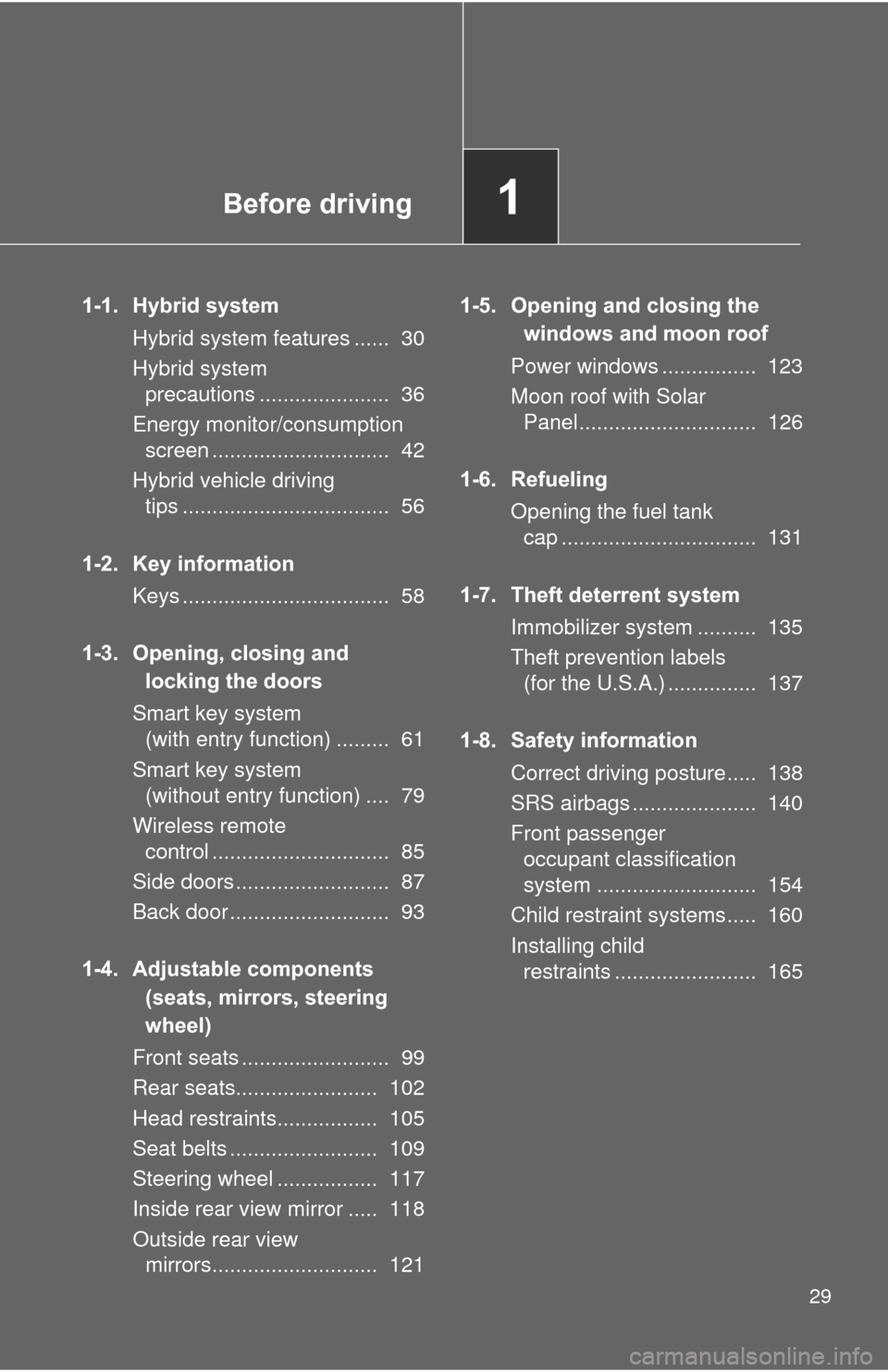
Before driving1
29
1-1. Hybrid systemHybrid system features ...... 30
Hybrid system precautions ...................... 36
Energy monitor/consumption screen .............................. 42
Hybrid vehicle driving tips ................................... 56
1-2. Key information Keys ................................... 58
1-3. Opening, closing and locking the doors
Smart key system (with entry function) ......... 61
Smart key system (without entry function) .... 79
Wireless remote control .............................. 85
Side doors .......................... 87
Back door ........................... 93
1-4. Adjustable components (seats, mirrors, steering
wheel)
Front seats ......................... 99
Rear seats........................ 102
Head restraints................. 105
Seat belts ......................... 109
Steering wheel ................. 117
Inside rear view mirror ..... 118
Outside rear view mirrors............................ 121 1-5. Opening and closing the
windows and moon roof
Power windows ................ 123
Moon roof with Solar Panel.............................. 126
1-6. Refueling Opening the fuel tank cap ................................. 131
1-7. Theft deterrent system Immobilizer system .......... 135
Theft prevention labels (for the U.S.A.) ............... 137
1-8. Safety information Correct driving posture..... 138
SRS airbags ..................... 140
Front passenger occupant classification
system ........................... 154
Child restraint systems..... 160
Installing child restraints ........................ 165
Page 99 of 636
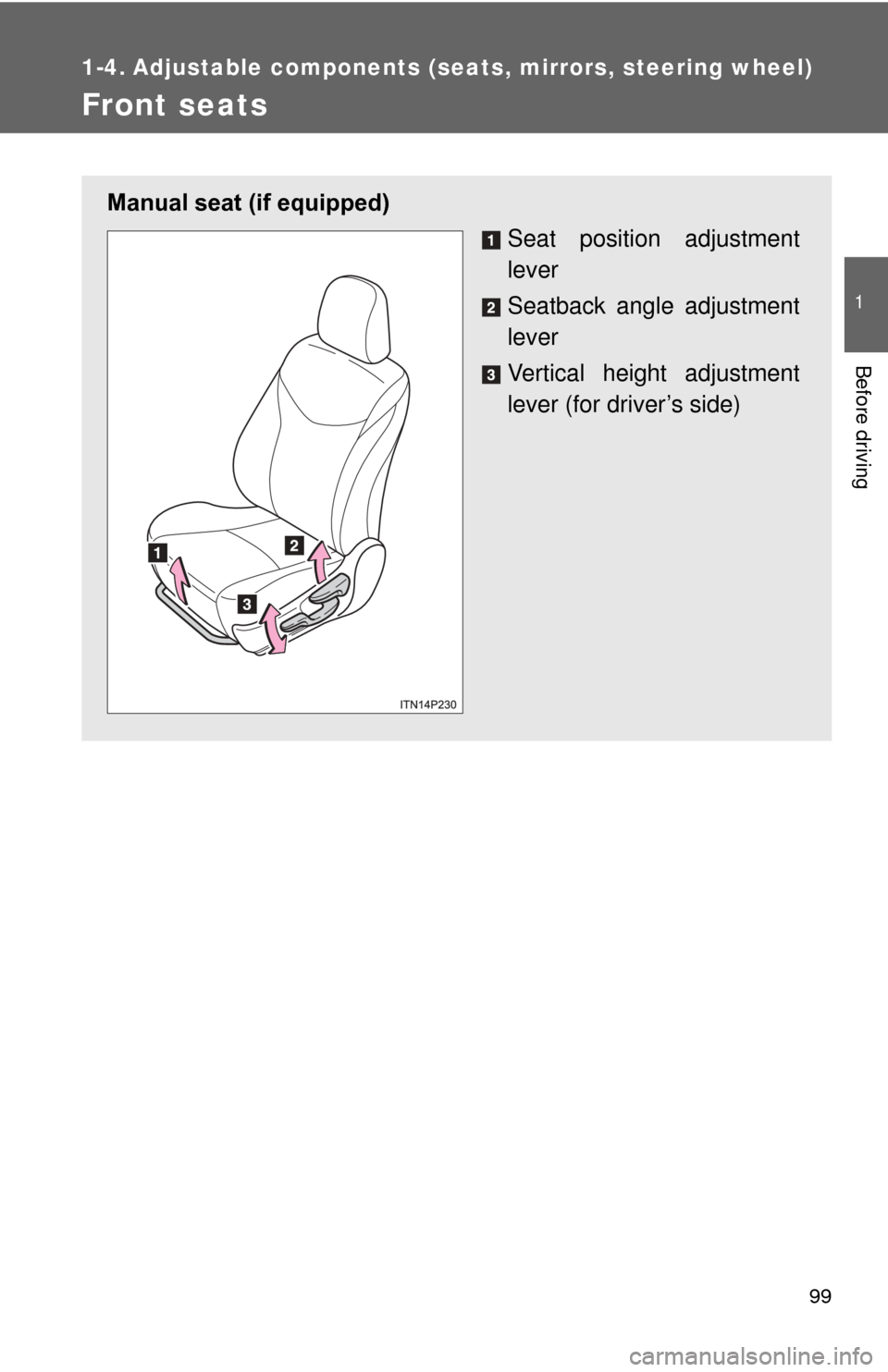
99
1
Before driving
1-4. Adjustable components (seats, mirrors, steering wheel)
Front seats
Manual seat (if equipped)
Seat position adjustment
lever
Seatback angle adjustment
lever
Vertical height adjustment
lever (for driver’s side)
Page 100 of 636
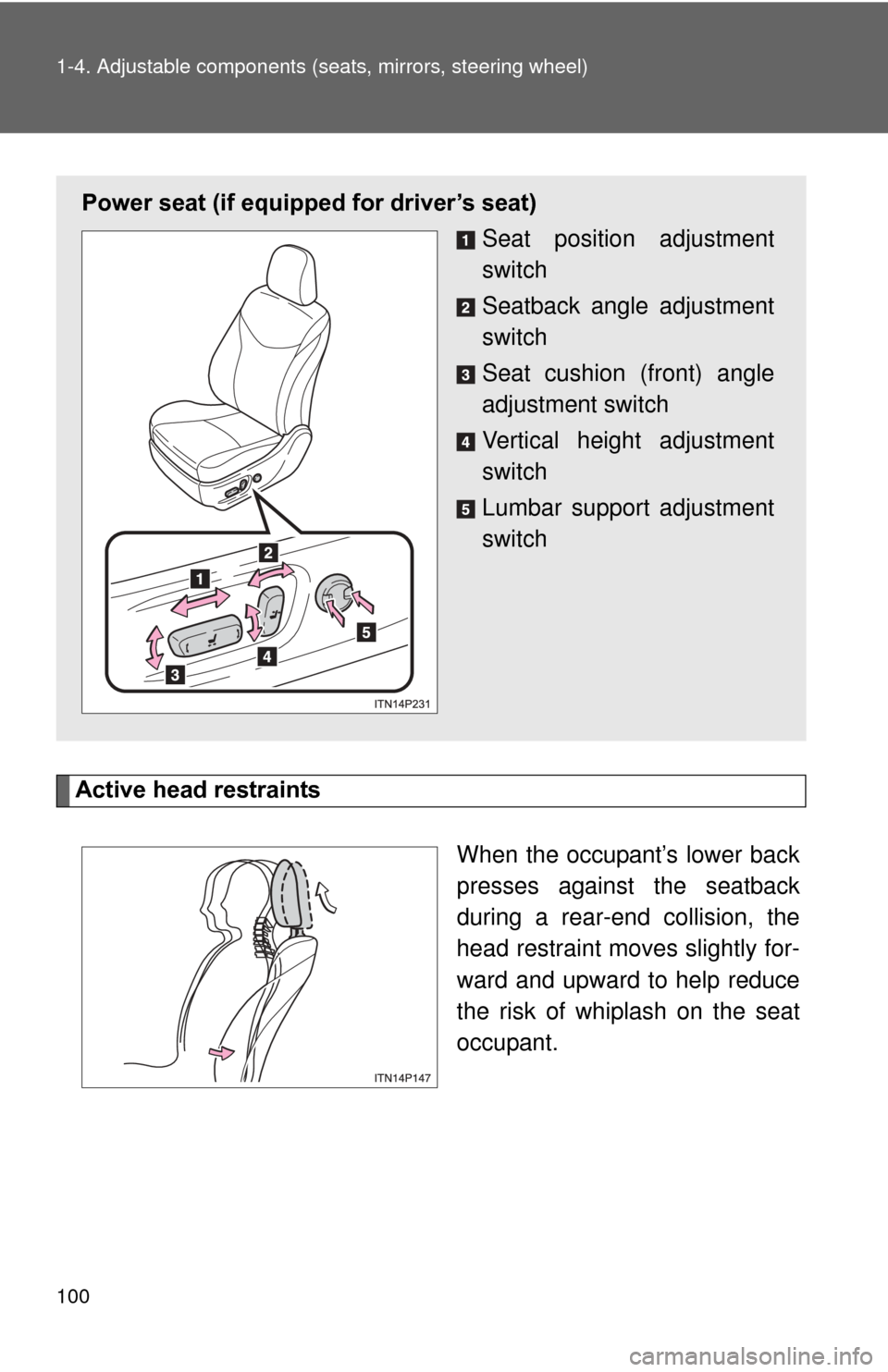
100 1-4. Adjustable components (seats, mirrors, steering wheel)
Active head restraints
When the occupant’s lower back
presses against the seatback
during a rear-end collision, the
head restraint moves slightly for-
ward and upward to help reduce
the risk of whiplash on the seat
occupant.
Power seat (if equipped for driver’s seat) Seat position adjustment
switch
Seatback angle adjustment
switch
Seat cushion (front) angle
adjustment switch
Vertical height adjustment
switch
Lumbar support adjustment
switch
Page 101 of 636
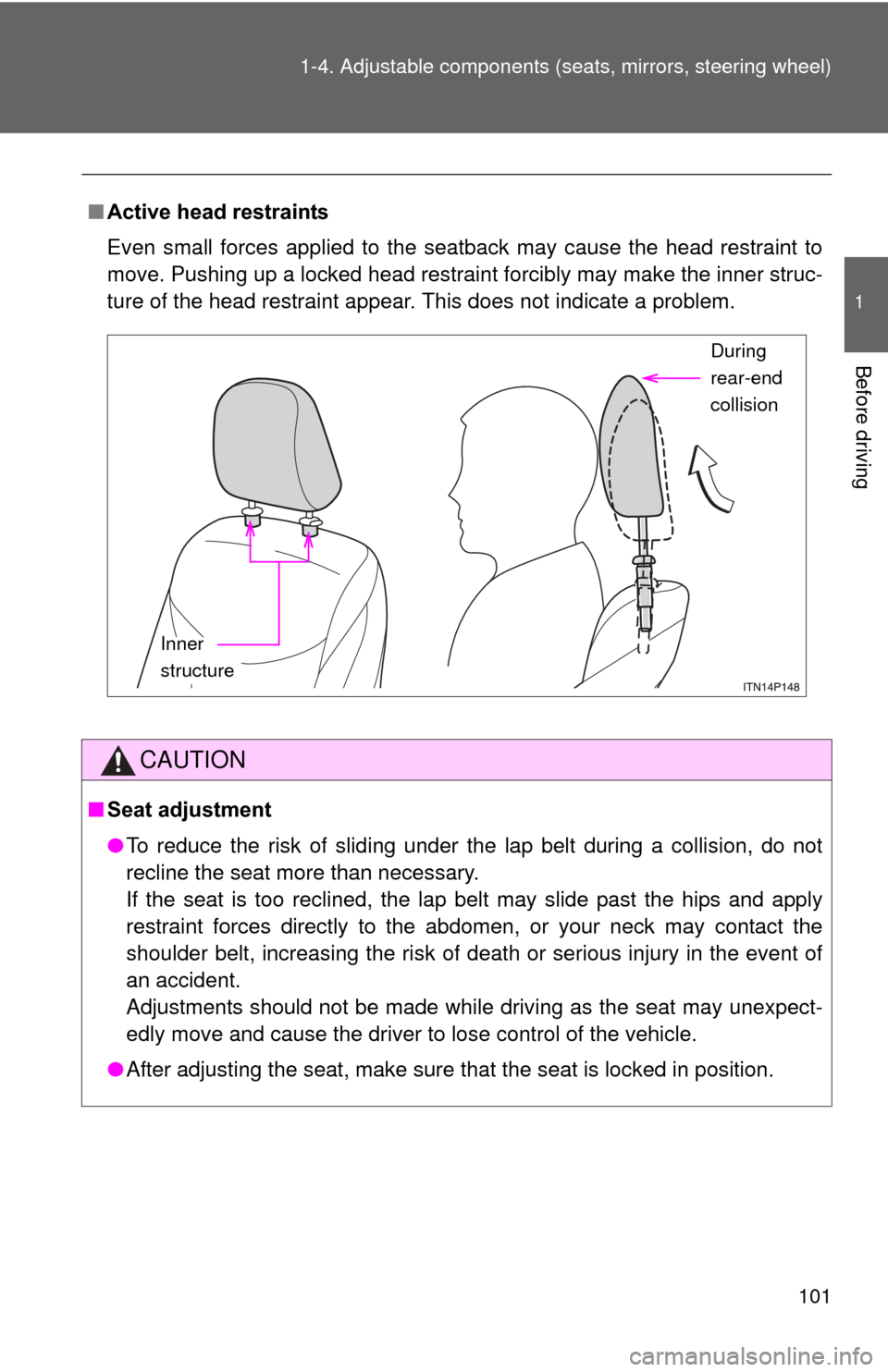
101
1-4. Adjustable components (s
eats, mirrors, steering wheel)
1
Before driving
■Active head restraints
Even small forces applied to the seatback may cause the head restraint to
move. Pushing up a locked head restraint forcibly may make the inner struc-
ture of the head restraint appear. This does not indicate a problem.
CAUTION
■Seat adjustment
●To reduce the risk of sliding under the lap belt during a collision, do not
recline the seat more than necessary.
If the seat is too reclined, the lap belt may slide past the hips and apply
restraint forces directly to the abdomen, or your neck may contact the
shoulder belt, increasing the risk of death or serious injury in the event of
an accident.
Adjustments should not be made while driving as the seat may unexpect-
edly move and cause the driver to lose control of the vehicle.
● After adjusting the seat, make sure that the seat is locked in position.
During
rear-end
collision
Inner
structure
Page 102 of 636
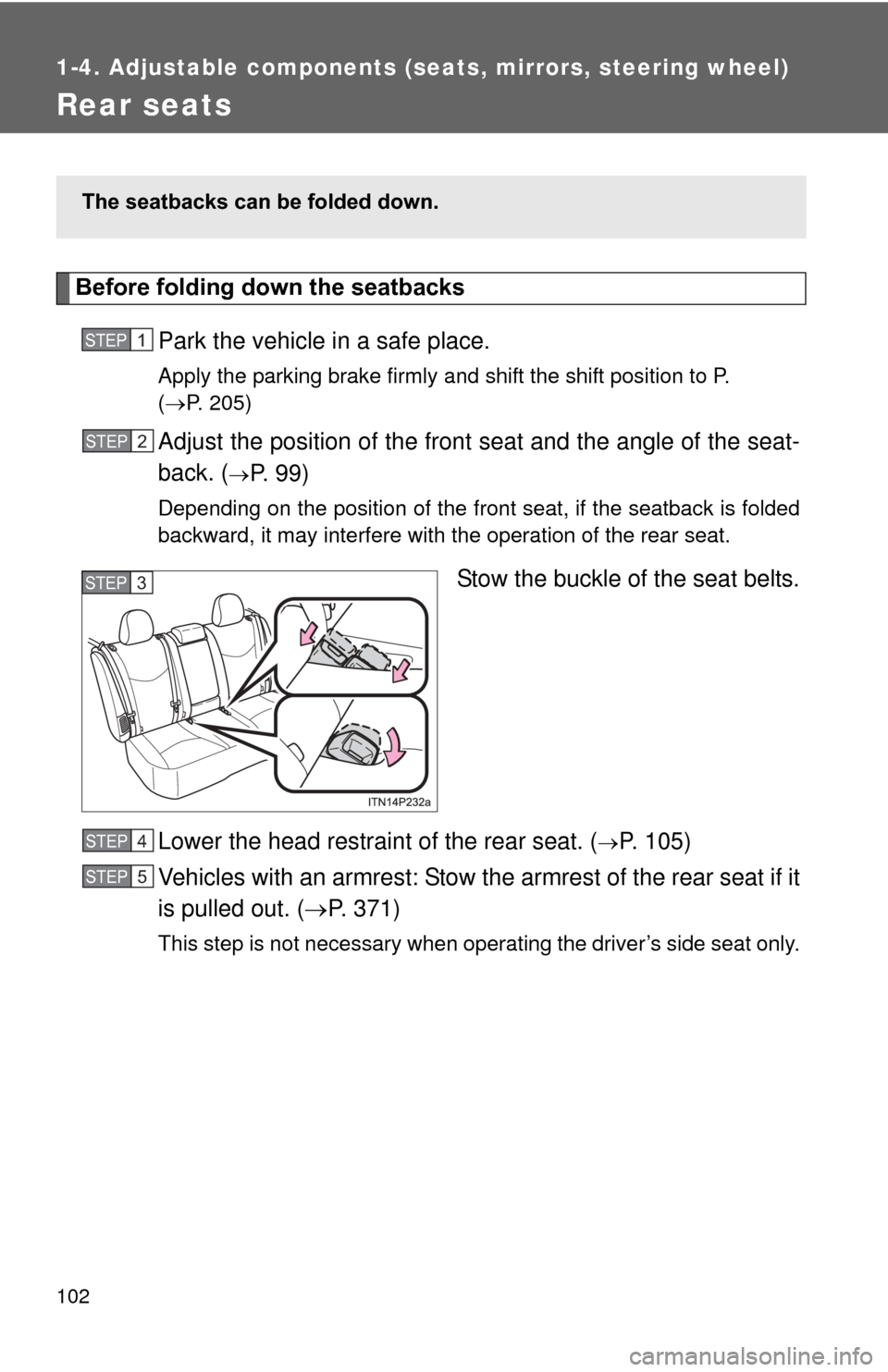
102
1-4. Adjustable components (seats, mirrors, steering wheel)
Rear seats
Before folding down the seatbacksPark the vehicle in a safe place.
Apply the parking brake firmly and shift the shift position to P.
(P. 205)
Adjust the position of the front seat and the angle of the seat-
back. (
P. 99)
Depending on the position of the front seat, if the seatback is folded
backward, it may interfere with the operation of the rear seat.
Stow the buckle of the seat belts.
Lower the head restraint of the rear seat. (
P. 105)
Vehicles with an armrest: Stow the armrest of the rear seat if it
is pulled out. ( P. 371)
This step is not necessary when operating the driver’s side seat only.
The seatbacks can be folded down.
STEP 1
STEP 2
STEP 3
STEP 4
STEP 5
Page 103 of 636
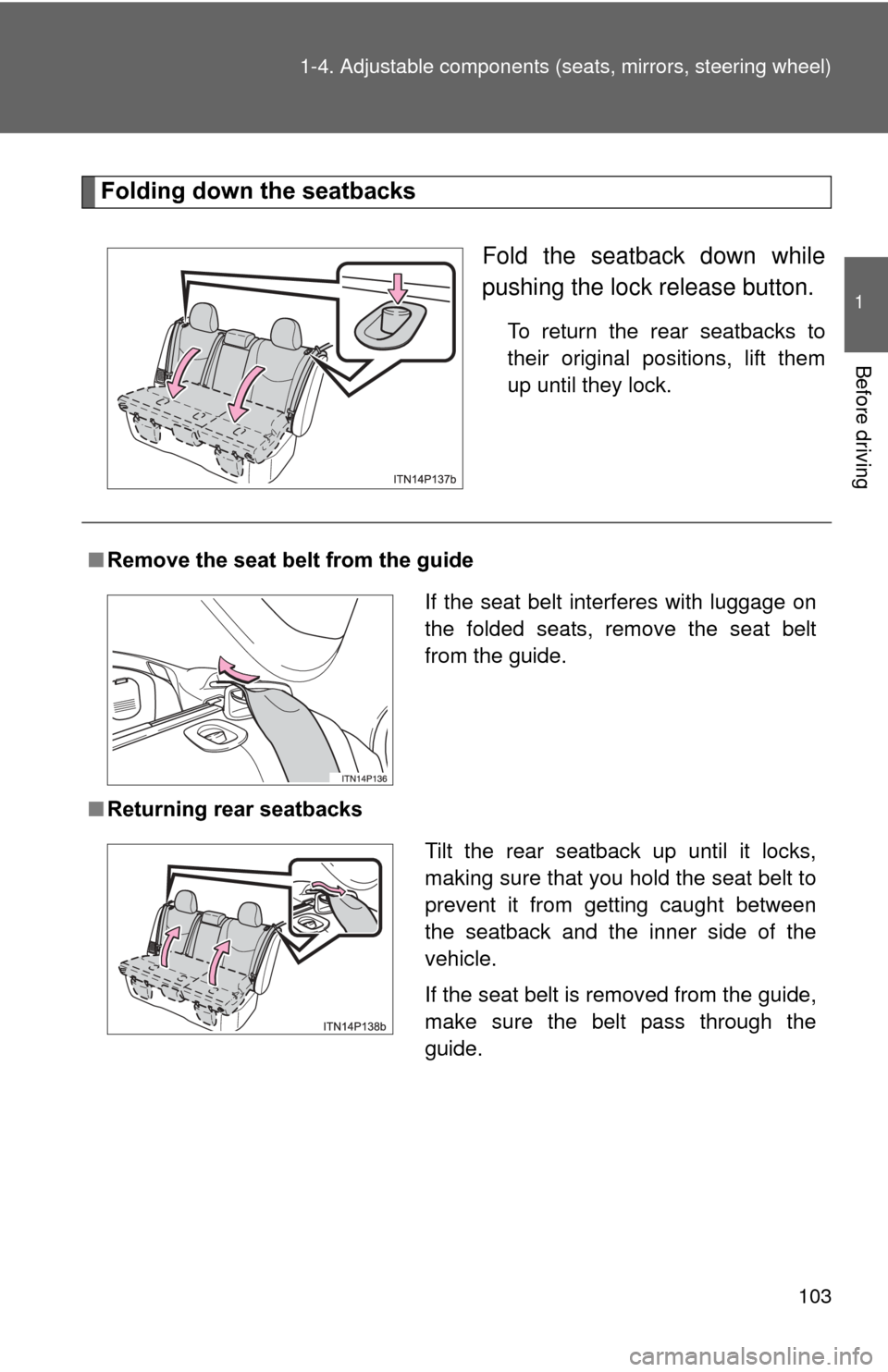
103
1-4. Adjustable components (s
eats, mirrors, steering wheel)
1
Before driving
Folding down the seatbacks
Fold the seatback down while
pushing the lock release button.
To return the rear seatbacks to
their original positions, lift them
up until they lock.
■Remove the seat belt from the guide
■ Returning rear seatbacks
If the seat belt interferes with luggage on
the folded seats, remove the seat belt
from the guide.
Tilt the rear seatback up until it locks,
making sure that you hold the seat belt to
prevent it from getting caught between
the seatback and the inner side of the
vehicle.
If the seat belt is removed from the guide,
make sure the belt pass through the
guide.
Page 104 of 636
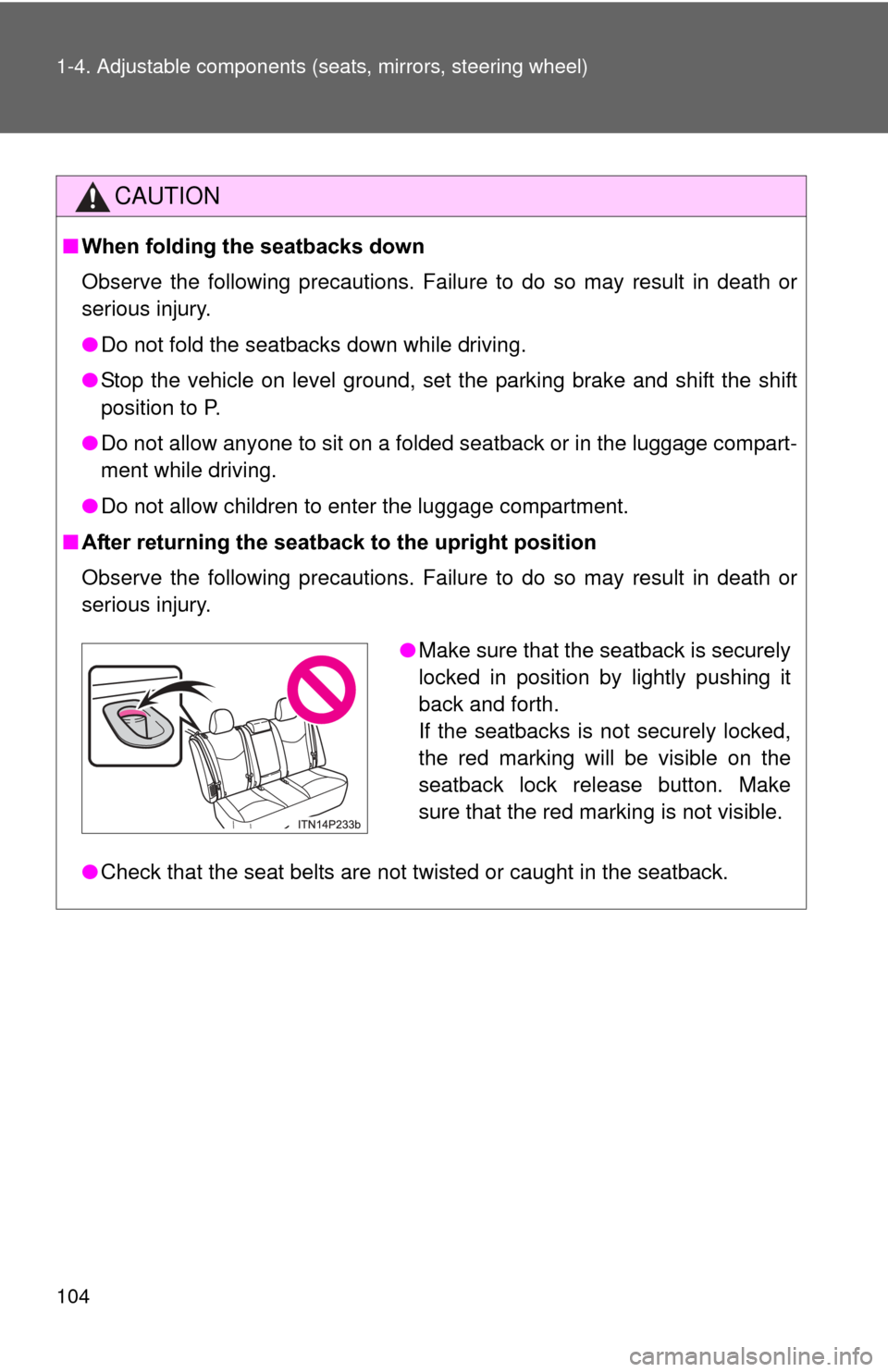
104 1-4. Adjustable components (seats, mirrors, steering wheel)
CAUTION
■When folding the seatbacks down
Observe the following precautions. Failure to do so may result in death or
serious injury.
●Do not fold the seatbacks down while driving.
● Stop the vehicle on level ground, set the parking brake and shift the shift
position to P.
● Do not allow anyone to sit on a folded seatback or in the luggage compart-
ment while driving.
● Do not allow children to enter the luggage compartment.
■ After returning the seatback to the upright position
Observe the following precautions. Failure to do so may result in death or
serious injury.
● Check that the seat belts are not twisted or caught in the seatback.
●Make sure that the seatback is securely
locked in position by lightly pushing it
back and forth.
If the seatbacks is not securely locked,
the red marking will be visible on the
seatback lock release button. Make
sure that the red marking is not visible.
Page 105 of 636
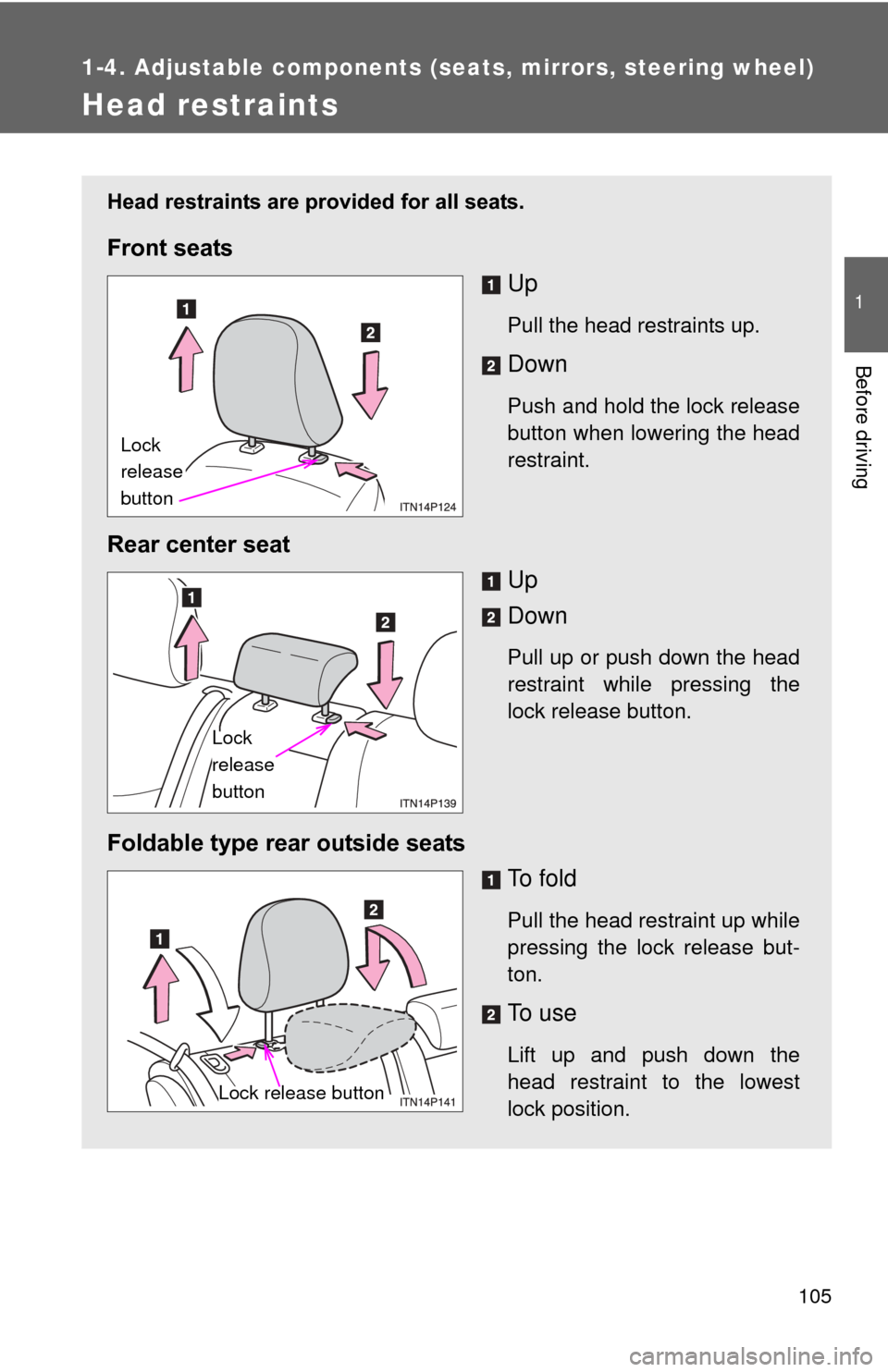
105
1
1-4. Adjustable components (seats, mirrors, steering wheel)
Before driving
Head restraints
Head restraints are provided for all seats.
Front seatsUp
Pull the head restraints up.
Down
Push and hold the lock release
button when lowering the head
restraint.
Rear center seatUp
Down
Pull up or push down the head
restraint while pressing the
lock release button.
Foldable type rear outside seats
To f o l d
Pull the head restraint up while
pressing the lock release but-
ton.
To u s e
Lift up and push down the
head restraint to the lowest
lock position.
Lock
release
button
Lock
release
button
Lock release button